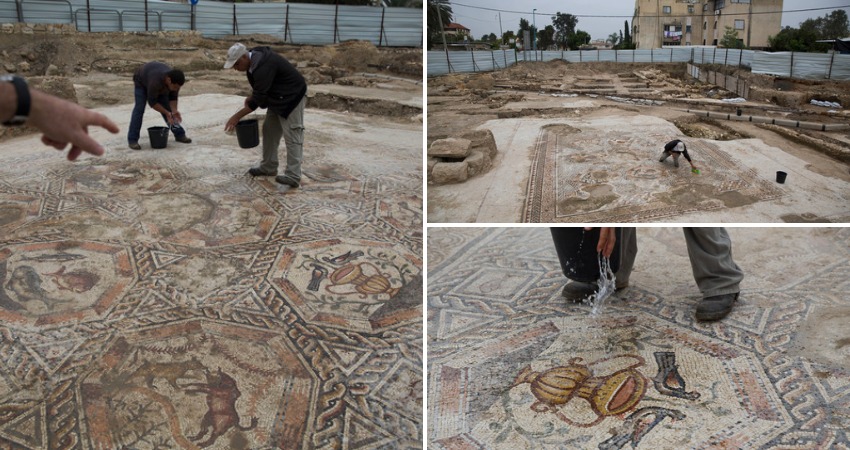Archaeologists have today unveiled a 1,700-year-old Roman-era mosaic in Israel.
The intricate floor was found last year while building a visitors’ center meant to display another mosaic, discovered two decades earlier at the same location.

The new mosaic measures 36ft by 42ft (11 meters by 13 meters) and paved the courtyard of a villa in an affluent neighborhood that stood during the Roman and Byzantine eras.
Scroll down for video

A partial view of a 1,700-year-old Roman-era mosaic floor in Lod, Israel, Monday, Nov. 16, 2015. Archaeologists found the mosaic last year while building a visitors center meant to display another mosaic, discovered two decades earlier at the same spot. The authority said the newly discovered Roman-era mosaic measures 11 meters by 13 meters (36 feet by 42 feet) and paved the courtyard of a villa in an affluent neighborhood that stood during the Roman and Byzantine eras. (AP Photo/Ariel Schalit)
Israel has, for the first time, presented to the public an ‘impressive’ mosaic accidentally discovered in what was a wealthy neighbourhood in Roman and Byzantine times. The colourful mosaic discovered in Lod in central Israel is believed to have been the courtyard pavement of a ‘magnificent villa’
Israel’s antiquities authority called the first mosaic ‘breathtaking’ and ‘among the most beautiful’ in Israel.
The quality of the images portrayed in the mosaic indicates a highly developed artistic ability,’ said Amir Gorzalczany, who directed the excavation.
The new mosaic was found just a few meters from the first one, in what is today the central Israeli city of Lod.

An employee of Israels antiquities authority works on a 1,700-year-old Roman-era mosaic floor in Lod, Israel, Monday, Nov. 16, 2015. Archaeologists found the mosaic last year while building a visitors center meant to display another mosaic, discovered two decades earlier at the same spot. The authority said the newly discovered Roman-era mosaic measures 11 meters by 13 meters (36 feet by 42 feet) and paved the courtyard of a villa in an affluent neighborhood that stood during the Roman and Byzantine eras. (AP Photo/Ariel Schalit)
An employee of Israels antiquities authority works on a 1,700-year-old Roman-era mosaic floor in Lod, Israel, Monday, Nov. 16, 2015. Archaeologists found the mosaic last year while building a visitors center meant to display another mosaic, discovered two decades earlier at the same spot. The authority said the newly discovered Roman-era mosaic measures 11 meters by 13 meters (36 feet by 42 feet) and paved the courtyard of a villa in an affluent neighborhood that stood during the Roman and Byzantine eras. (AP Photo/Ariel Schalit)
The authority said the mosaic discovered in the 1990s covered the villa’s living room while the newly discovered one was in its courtyard.
It added that numerous fragments of frescoes discovered also ‘reflect the decoration and the meticulous and luxurious design, which are in the best tradition of the well-born of the period’.
Neither mosaic has human figures orreligious symbols, which makes it tricky for archaeologists to know who exactly lived in the villa.
The tiles, however, do depict animals that were known to people who lived during the Roman and Byzantine periods in Israel.

Employees of Israels antiquities authority works on a 1,700-year-old Roman-era mosaic floor in Lod, Israel, Monday, Nov. 16, 2015. Archaeologists found the mosaic last year while building a visitors center meant to display another mosaic, discovered two decades earlier at the same spot. The authority said the newly discovered Roman-era mosaic measures 11 meters by 13 meters (36 feet by 42 feet) and paved the courtyard of a villa in an affluent neighborhood that stood during the Roman and Byzantine eras. (AP Photo/Ariel Schalit)

The original mosaic has been displayed at the Metropolitan Museum in New York, the Louvre in Paris, and the Hermitage museum in St. Petersburg.
It is currently on display at the Cini Gallery in Venice, Italy, and is expected to return to Lod after the visitors’ center is complete.
It said that ‘in light of the new discoveries, this part of the villa will also be incorporated in the visitor centre’.
Lod was destroyed by the Romans in A.D. 66 during the Jewish War. It was founded again by Hadrian under the name Diospolis.
The city was later awarded the rank of a Roman colony under Septimius Severus in A.D. 200.
It city remained under Roman control until becoming a Christian settlement and eventually succumbing to Arab conquerors in A.D. 636.
Today it is located near Tel Aviv’s Ben Gurion international airport


Leave a Reply